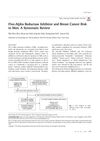Search
for
Sort by
Research
30-60 / 1000+ resultsresearch Efficacy of Finasteride for Treating Patients with Androgenetic Alopecia Who Are Pileous in Other Areas: A Pilot Study in Japan

research Bitemporal Scalp Hair Loss: Differential Diagnosis of Nonscarring and Scarring Conditions
Understanding the cause of bitemporal hair loss is key to deciding the right treatment.

research Oral Minoxidil Treatment for Hair Loss: A Review of Efficacy and Safety
Oral minoxidil promotes hair growth but may cause side effects; needs monitoring.

research Faculty Opinions Recommendation of Dutasteride Improves Male Pattern Hair Loss in a Randomized Study in Identical Twins
Dutasteride helps reduce male pattern hair loss, but may cause side effects like altered libido and erectile dysfunction.

research Cross-Sectional Study on Prescription Habits in Androgenetic Alopecia Among Dermatologists in Spain in 2017
In 2017, Spanish dermatologists most often prescribed minoxidil and finasteride for male hair loss, and minoxidil and oral contraceptives for premenopausal female hair loss.

research 5-Alpha-Reductase Inhibitor Treatment for Frontal Fibrosing Alopecia: A Myth or Truth?
5-Alpha-Reductase inhibitors might help slow down hair loss in Frontal Fibrosing Alopecia but are not a primary treatment and need more research.

research Androgenetic Alopecia: A Review and Emerging Treatments
Hair loss, known as Androgenetic Alopecia, is often caused by hormones and can be diagnosed using noninvasive techniques. Treatments include topical minoxidil and oral finasteride, with new treatments being explored. There may also be a link between this type of hair loss and heart disease risk.

research Effectiveness of Terbinafine in Treating Toenail Onychomycosis and Associated Studies
Terbinafine is more effective than itraconazole for toenail fungus, especially in older patients, and debridement improves its effectiveness.

research Safety of Low-Dose Oral Minoxidil Treatment for Hair Loss: A Systematic Review and Pooled Analysis of Individual Patient Data
Low-dose oral minoxidil is a safe treatment for hair loss, with the main side effect being excessive hair growth. Other side effects like foot swelling, low blood pressure when standing, and heart rate changes are rare.

research Treatment Strategies for Alopecia
Some treatments work for common baldness, but there's less evidence for other hair loss types, and more research is needed.

research Sleep Problems Are Associated with Development and Progression of Lower Urinary Tract Symptoms: Results from REDUCE
Poor sleep is linked to a higher risk of developing and worsening urinary problems in men.

research What Ages Hair?
Hair aging and loss are caused by genetics, hormones, environment, and grooming, with treatments like minoxidil effective for certain types of hair loss.

research What Ages Hair?
Hair aging is inevitable, but using the right hair care products can help maintain hair health.

research Anal Involvement in Pemphigus Vulgaris: Study on Recurrence and Treatment Outcomes
Most patients with anal Pemphigus Vulgaris had repeated episodes but fully recovered with treatment, without long-term problems.
research Inhibition of 5α-Reductase in the Rat Prostate by Cimicifuga Racemosa
Cimicifuga racemosa extract may help prevent and treat prostate issues by inhibiting 5α-reductase.

research Combination and Rotational Therapy in Androgenetic Alopecia
Using different hair loss treatments at various times can improve results and reduce side effects for people with chronic hair loss.
research Treatment of Androgenetic Alopecia: Current Guidance and Unmet Needs
More personalized and effective treatments for androgenetic alopecia are needed.

research A Model for the Turnover of Dihydrotestosterone in the Presence of the Irreversible 5α-Reductase Inhibitors GI198745 and Finasteride
Both drugs lower DHT levels, with GI198745 being more effective.

research Five-Alpha Reductase Inhibitor and Breast Cancer Risk in Men: A Systematic Review
Taking 5-alpha reductase inhibitors does not increase breast cancer risk in men.

research Bicalutamide: A Potential New Oral Antiandrogenic Drug for Female Pattern Hair Loss
Bicalutamide may be a promising alternative treatment for female pattern hair loss.

research Platelet-Rich Plasma with Low Dose Oral Minoxidil (1.25 mg Versus 2.5 mg) Along with Trichoscopic Pre- and Post-Treatment Evaluation
Combining platelet-rich plasma therapy with low dose oral minoxidil improved hair growth in men with hair loss, with slightly higher satisfaction at the higher minoxidil dose.

research Adverse Events with Finasteride or Dutasteride: FAERS
Lower finasteride doses had more side effects; dutasteride caused back pain; more research needed on post-finasteride syndrome.

research Effect of 5α-Reductase Inhibitors on Sexual Function: New Contributions
5-alpha reductase inhibitors increase the risk of sexual dysfunction in patients treating enlarged prostate but not in those treating hair loss.

research Finasteride 5mg and Sexual Side Effects: How Many Are Related to a Nocebo Phenomenon?
Knowing about finasteride's sexual side effects increases reported dysfunction.

research Dutasteride, A Novel Dual 5-Alpha Reductase Inhibitor, Reduces Serum DHT to a Greater Extent Versus Finasteride and Achieves Maximal Reduction in a Larger Proportion of Patients
Dutasteride reduces DHT more effectively than finasteride.

research Evidence-Based Guideline for the Treatment of Androgenetic Alopecia in Women and Men
Use minoxidil for hair loss; finasteride and dutasteride for men, dutasteride for women.

research Outcomes of Androgenetic Alopecia Treated with Dutasteride Mesotherapy: A Case Series
Dutasteride mesotherapy showed mixed results and is not recommended as a primary treatment for hair loss.

research Inhibitors of 5α-Reductase in the Treatment of Benign Prostatic Hyperplasia
5α-reductase inhibitors and alpha-1 adrenergic antagonists together effectively treat benign prostatic hyperplasia, with long-term benefits.

research Interventions for Female Pattern Hair Loss
Topical minoxidil helps treat female pattern hair loss, but more research needed for other treatments.